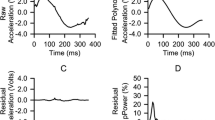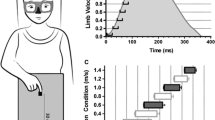Abstract
A recent experiment by Boyle et al. (Exp Brain Res 223:377–387, 2012a) demonstrated that providing a sine-wave template for participants to follow enhances performance and transfer on difficult (ID = 6) Fitts tasks. Another experiment (Fernandez and Bootsma in Acta Psychol 129:217–227, 2008) demonstrated the effectiveness of applying a nonlinear transformation of the visual feedback provided to participants executing difficult aiming movements. The present experiment was designed to determine whether these two enhancements when used together would provide further enhancements to difficult aiming movements. Participants were randomly assigned to one of the three acquisition conditions. Participants in the Fitts and Fittslog condition were asked to flex/extend their arm in the horizontal plane at the elbow joint (wrist stabilized) in an attempt to move back and forth between two targets as quickly and accurately as possible. In the Sinelog condition, participants were asked to track a sine-wave pattern. The timing for Sinelog conditions was set to result in total times (movement time + dwell time) similar to that anticipated for the Fittslog condition. The feedback displays for Fittslog and Sinelog groups were subjected to a nonlinear transformation, but not for the Fitts group. Following 54 acquisition trials (17.5 s each) under their assigned condition, Test 1 was conducted under the same conditions as the participant experienced during the acquisition trials and Test 2 was conducted under Fitts conditions with the nonlinear transformation of the display data. Test 3 was conducted under typical Fitts conditions with no transformation of the display data. The results for Tests 1 and 2 indicated that total time and movement time for the Fittslog and Sinelog groups were reduced relative to the Fitts condition. In addition, dwell time was significantly lower, a larger proportion of movement time was spent in the acceleration portion of the movement, and normalized peak velocity was significantly lower for the participants in the Sinelog condition than for participants in the Fittslog condition. On Test 3, an untransformed Fitts condition was imposed; the Sinelog group outperformed the Fittslog condition on all variables except hits, endpoint variability, and peak velocity where the Fittslog and Sinelog groups performed similarly.




Similar content being viewed by others
References
Balakrishnan I, MacKenzie IS (1997) Performance differences in the fingers, wrist, and forearm in computer input control. In: Proceedings of the CHT’97 conference on human factors in computing systems. ACM, New York, pp 303–310
Beggs WDA, Howarth CI (1972) The accuracy of aiming at a target: some further evidence for a theory of intermittent control. Acta Psychol 36:171–177
Blandin Y, Toussaint L, Shea CH (2008) Specificity of practice: interaction between concurrent sensory information and terminal feedback. J Exp Psychol Learn Mem Cogn 34:994–1000
Bohan M, McConnell DS, Chaparro A, Thompson SG (2010) The effects of visual magnification and physical movement scale on the manipulation of a tool with indirect vision. J Exp Psychol Appl 16:33–34
Boyle J, Shea CH (2011) Wrist and arm movements of varying difficulties. Acta Psychol 137:382–396
Boyle J, Kennedy D, Shea CH (2012a) Optimizing the control of high ID single degree of freedom movements: re-thinking the obvious. Exp Brain Res 223:377–387
Boyle J, Panzer S, Shea CH (2012b) Increasingly complex bimanual multi-frequency coordination patterns are equally easy to perform with on-line relative velocity feedback. Exp Brain Res 216:515–525
Boyle J, Panzer S, Wright D, Shea CH (2012c) Extended practice of reciprocal wrist and arm movements of varying difficulties. Acta Psychol 140:142–153
Buchanan JJ, Park J-H, Ryu YU, Shea CH (2003) Discrete and cyclical units of action in a mixed target pair aiming task. Exp Brain Res 150:473–489
Buchanan JJ, Park J-H, Shea CH (2004) Systematic scaling of target width: dynamics, planning, and feedback. Neurosci Lett 367:317–322
Buchanan JJ, Park J-H, Shea CH (2006) Target width scaling in a repetitive aiming task: switching between cyclical and discrete units of action. Exp Brain Res 175:710–725
Carey JR, Kimberley TJ, Lewis SM, Auerbach EJ, Dorsey L, Rundquist P, Ugurbil K (2002) Analysis of fMRI and finger tracking training in subjects with chronic stroke. Brain 125:773–788
Casiez G, Vogel D, Balakrishnan R, Cockburn A (2008) The impact of control-display gain on user performance in pointing tasks. Hum Comput Interact 23:215–250
Coull J, Tremblay L, Elliott D (2001) Examining the specificity of practice hypothesis: is learning modality specific? Res Q Exerc Sport 72:345–354
Crossman ERFW, Goodeve PJ (1963) Feedback control of hand movement and Fitts’ law. Q J Exp Psychol 35A:251–278
Debaere F, Swinnen SP, Beatse E, Sunaert S, VanHecke P, Duysens S (2001) Brain areas involved in interlimb coordination: a distributed network. Neuroimage 14:947–958
Debaere F, Wenderoth N, Sunaert S, Van Hecke P, Swinnen SP (2003) Internal vs external generation of movements: differential neural pathways involved in bimanual coordination performed in the presence or absence of augmented visual feedback. Neuroimage 19:764–776
Dounskaia N, Wisleder D, Johnson T (2005) Influence of biomechanical factors on substructure of pointing movements. Exp Brain Res 164:505–516
Elliott D, Lyons J, Dyson K (1997) Rescaling an acquired discrete aiming movement: specific or general motor learning? Hum Move Sci 16:81–96
Elliott D, Helsen WF, Chua R (2001) A century later: woodworth’s (1989) two component model of goal-directed aiming. Psychol Bull 127:342–357
Elliott D, Hansen S, Grierson LEM, Lyons J, Bennett SJ, Hayes SJ (2010) Goal directed aiming: two components but multiple processes. Psychol Bull 136:1023–1044
Ellis RD, Cao A, Pandya A, Composto A, Chacko M, Klein MD, Auner G (2004) Optimizing the surgeon-robot interface: the effect of control-display zoom level on movement time. In: Proceedings of the 48th annual meeting of the Human Factors and Ergonomics Society. HFES, New Orleans, LA
Fernandez L, Bootsma RJ (2008) Non-linear gaining in precision aiming: making Fitts’ task a bit easier. Acta Psychol 129:217–227
Fitts PM (1954) The information capacity of the human motor system in controlling the amplitude of movement. J Exp Psychol 47:381–391
Fradet L, Lee G, Dounskaia N (2008) Origins of submovements during pointing movements. Acta Psychol 129:91–100
Guiard Y (1993) On Fitts’s and Hooke’s laws: simple harmonic movement in upper-limb cyclical aiming. Acta Psychologica 82:139–159
Guiard Y (1997) Fitts’ law in the discrete vs. cyclical paradigm. Hum Move Sci 16:97–131
Guiard Y, Beaudouin-Lafon M, Mottet D (1999) Navigation as multiscale pointing: extending fitts’ model to very high precision tasks. In: Proceedings of the SIGCHI conference on human factors in computing systems. ACM, New York, pp 450–457
Harris CM, Wolpert DM (1998) Signal-dependent noise determines motor planning. Nature 394:780–784
Huet M, Camachon C, Fernandez L, Jacob DM, Montagne G (2009) Self-controlled concurrent feedback and the education of attention towards perceptual invariants. Hum Move Sci 28:450–467
Huet M, Camachon C, Gray R, Jacob DM, Missenard O, Montagne G (2011) The education of attention as explanation of variability of practice effects: learning the final approach in a flight simulator. J Exp Psychol Hum Percept Perform 37:1841–1854
Jellinek HD, Card SK (1990) Power mice and user performance. In: Proceedings of the CHI 1990 conference on human factors in computing systems. ACM, New York
Keele SW (1968) Movement control in skilled motor performance. Psychol Bull 70:387
Kennedy D, Boyle J, Shea CH (2013) The role of visual and auditory models in the production bimanual tapping patterns. Exp Brain Res 224:507–518
Khan M, Elliott D, Coull J, Chua R, Lyons J (2002) Optimal control strategies under different feedback schedules: kinematic evidence. J Mot Behav 34:45–57
Knutson JS, Harley MY, Hisel TZ, Hogan SD (2012) Contralaterally controlled functional electrical stimulation for upper extremity hemiplegia: an early-phase randomized clinical trial in subacute stroke patients. Neuroreh Neural Repair 26:239–246
Kovacs AJ, Shea CH (2011) The learning of 90° continuous relative phase with and without Lissajous feedback: external and internally generated bimanual coordination. Acta Psychol 136:311–320
Kovacs AJ, Buchanan JJ, Shea CH (2008) Perceptual influences on Fitts’ law. Exp Brain Res 190:99–103
Kovacs AJ, Buchanan JJ, Shea CH (2010a) Perceptual and attentional influences on continuous 2:1 and 3:2 multi-frequency bimanual coordination. J Exp Psychol Hum Percept Perform 36:936–954
Kovacs AJ, Buchanan JJ, Shea CH (2010b) Impossible is nothing: 5:3 and 4:3 multi-frequency bimanual coordination. Exp Brain Res 201:249–259
Langolf GD, Chaffin DB, Foulke JA (1976) An investigation of Fitts’ law using a wide range of movement amplitudes. J Mot Behav 8:113–128
Meyer DE, Smith JEK, Wright CE (1982) Models for the speed and accuracy of aimed movements. Psychol Rev 89:449–482
Meyer DE, Abrams RA, Kornblum S, Wright CE, Smith JE (1988) Optimality in human motor performance: ideal control rapid aimed movements. Psychol Rev 93:340–370
Miall RC, Wolpert DM (1996) Forward models for physiological motor control. Neural Netw 9:1265–1279
Proteau L (1995) Sensory integration in the learning of an aiming task. Can J Exp Psych 49:113–120
Proteau L (2005) Visual afferent information dominates other sources of afferent information during mixed practice of a manual aiming task. Exp Brain Res 161:441–456
Salmoni AW, Schmidt RA, Walter CB (1984) Knowledge of results and motor learning: a review and critical reappraisal. Psychol Bull 95:355–386
Schmidt RA, Wulf G (1997) Continuous concurrent feedback degrades skill learning: implication for training and simulation. Hum Factors 39:509–525
Schmidt RA, Zelaznik H, Frank JS (1978) Sources of inaccuracy in rapid movements. In: Stelmach GE (ed) Information processing in motor control and learning. Academic Press, New York, pp 183–203
Schmidt RA, Zelaznik H, Hawkins B, Frank JS, Quinn JT (1979) Motor-output variability: a theory for the accuracy of rapid motor acts. Psychol Rev 86:415–451
Shea CH, Boyle J, Kovacs AJ (2012) Bimanual Fitts’ tasks: Kelso, Southard, and Goodman, 1979 revisited. Exp Brain Res 216:113–121
Wang C, Boyle J, Kennedy DM, Shea CH (2013) A guide to performing difficult bimanual coordination tasks: just follow the yellow brick road. Exp Brain Res 230:31–40. doi:10.1007/s00221-013-3628-8
Winstein CJ, Schmidt RA (1990) Reduced frequency of knowledge of results enhances motor skill learning. J Exp Psychol Learn Mem Cogn 16:677–691
Winstein CJ, Pohl PS, Lewthwaite R (1994) Effects of physical guidance and knowledge of results on motor learning: support for the guidance hypothesis. Res Q Exerc Sport 65:316–323
Wisleder D, Dounskaia N (2007) The role of different submovement types during pointing to a target. Exp Brain Res 176:132–149
Woodworth RS (1899) The accuracy of voluntary movement. Psychol Rev 3:1–114
Wulf G, Schmidt RA (1989) The learning of generalized motor programs: reducing the relative frequency of knowledge of results enhances memory. J Exp Psychol Learn Mem Cogn 15:748–757
Author information
Authors and Affiliations
Corresponding author
Rights and permissions
About this article
Cite this article
Boyle, J.B., Panzer, S., Wang, C. et al. Optimizing the control of high-ID movements: rethinking the power of the visual display. Exp Brain Res 231, 479–493 (2013). https://doi.org/10.1007/s00221-013-3712-0
Received:
Accepted:
Published:
Issue Date:
DOI: https://doi.org/10.1007/s00221-013-3712-0




